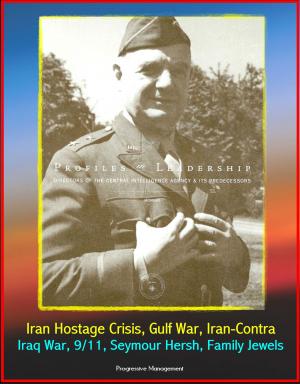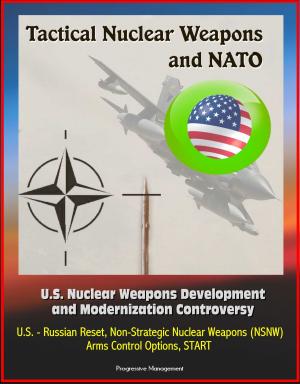Death Spiral: Luftwaffe Airlift Training, Operation Stosser, and Lessons for Modern U.S. Air Force - Highlighting Perils of Cutbacks in Aircraft Training and Proficiency Compared to C-17 Pilot Force
Nonfiction, History, Military, Aviation, World War II| Author: | Progressive Management | ISBN: | 9781370699452 |
| Publisher: | Progressive Management | Publication: | January 29, 2017 |
| Imprint: | Smashwords Edition | Language: | English |
| Author: | Progressive Management |
| ISBN: | 9781370699452 |
| Publisher: | Progressive Management |
| Publication: | January 29, 2017 |
| Imprint: | Smashwords Edition |
| Language: | English |
This excellent report has been professionally converted for accurate flowing-text e-book format reproduction. In the face of shrinking budgets and wartime mission demands, the United States Air Force (USAF) C-17 pilot force endured cutbacks to aircraft training and proficiency over the last fourteen years not unlike those the Luftwaffe endured as World War II progressed. In light of recent modifications to airlift training programs, this monograph analyzes a historical case study of the perils of such action to highlight the similarities between the present day training reductions of the USAF, and those of the Luftwaffe between 1939 and 1944 for the reference and consideration of Air Mobility Command. Comparing how the modern USAF airlift force trains C-17 pilots to the programs and results of the Luftwaffe during World War II reveals striking similarities in the methods both forces used to find efficiencies and cut costs. Furthermore, analysis of the results of these cuts reveals not only that the Luftwaffe destroyed their airlift training programs to the point of operational failure in the execution of Operation Stosser, but that the USAF is potentially on a similar path toward marginalizing its own airlift capabilities.
1. Introduction: The Death Spiral * 2. Section One: American Combat Airlift: History, Theory Doctrine * 3. Section Two: The Rise and Fall of Luftwaffe Airlift Training * 4. Section Three: The Failure of Operation Stosser * 5. Section Four: The Luftwaffe's Shadow: Reductions in USAF Airlift Training * 6. Conclusion: Lessons in Parallel
The daunting challenges the Luftwaffe faced on the night of December 17, 1944 in the execution of Operation Stosser came about for a multitude of reasons. This operation, meant to secure the northern flank of the German thrust toward Antwerp, called upon atrophied skills and long-forgotten methods to achieve success. The airlift pilot force was largely unqualified, the result of years of reduced training prioritization and combat fatigue which left the air transportation elements of the Luftwaffe impotent. Yet operational failures as a result of atrophied training will likely occur once again; the German lessons of reduced training and crippled capability going unlearned or ignored. What lessons can the modern United States Air Force (USAF) learn from the Luftwaffe's reduction of airlift aircrew training and the December 1944 failure of Operation Stosser?
The aim of this monograph is to highlight trends of historical significance to the USAF's Air Mobility Command (AMC) as it faces flying training reductions resulting from budgetary limitations and increased operations tempo. Doing so requires an examination of the history, theory, and doctrine behind combat airlift training and proficiency in the current USAF and AMC, providing an abstract through which to evaluate both the Luftwaffe's reduced training programs prior to Operation Stosser, and recent trends in the USAF C-17 fleet.
This excellent report has been professionally converted for accurate flowing-text e-book format reproduction. In the face of shrinking budgets and wartime mission demands, the United States Air Force (USAF) C-17 pilot force endured cutbacks to aircraft training and proficiency over the last fourteen years not unlike those the Luftwaffe endured as World War II progressed. In light of recent modifications to airlift training programs, this monograph analyzes a historical case study of the perils of such action to highlight the similarities between the present day training reductions of the USAF, and those of the Luftwaffe between 1939 and 1944 for the reference and consideration of Air Mobility Command. Comparing how the modern USAF airlift force trains C-17 pilots to the programs and results of the Luftwaffe during World War II reveals striking similarities in the methods both forces used to find efficiencies and cut costs. Furthermore, analysis of the results of these cuts reveals not only that the Luftwaffe destroyed their airlift training programs to the point of operational failure in the execution of Operation Stosser, but that the USAF is potentially on a similar path toward marginalizing its own airlift capabilities.
1. Introduction: The Death Spiral * 2. Section One: American Combat Airlift: History, Theory Doctrine * 3. Section Two: The Rise and Fall of Luftwaffe Airlift Training * 4. Section Three: The Failure of Operation Stosser * 5. Section Four: The Luftwaffe's Shadow: Reductions in USAF Airlift Training * 6. Conclusion: Lessons in Parallel
The daunting challenges the Luftwaffe faced on the night of December 17, 1944 in the execution of Operation Stosser came about for a multitude of reasons. This operation, meant to secure the northern flank of the German thrust toward Antwerp, called upon atrophied skills and long-forgotten methods to achieve success. The airlift pilot force was largely unqualified, the result of years of reduced training prioritization and combat fatigue which left the air transportation elements of the Luftwaffe impotent. Yet operational failures as a result of atrophied training will likely occur once again; the German lessons of reduced training and crippled capability going unlearned or ignored. What lessons can the modern United States Air Force (USAF) learn from the Luftwaffe's reduction of airlift aircrew training and the December 1944 failure of Operation Stosser?
The aim of this monograph is to highlight trends of historical significance to the USAF's Air Mobility Command (AMC) as it faces flying training reductions resulting from budgetary limitations and increased operations tempo. Doing so requires an examination of the history, theory, and doctrine behind combat airlift training and proficiency in the current USAF and AMC, providing an abstract through which to evaluate both the Luftwaffe's reduced training programs prior to Operation Stosser, and recent trends in the USAF C-17 fleet.















